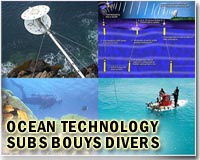| . |  |
. |
Paris, France (ESA) Feb 11, 2011 Our growing reliance on coastal waters for food, trade and tourism means that these delicate ecosystems need to be more closely monitored to guarantee their future sustainability. ESA's CoastColour project is helping scientists develop techniques to take full advantage of the unique capabilities of the Medium Resolution Imaging Spectrometer (MERIS) sensor on its Envisat satellite. With a resolution of 300 m, MERIS provides the sharpest view of coastal waters to date, and includes spectral bands specially designed to characterise the complex mixing of pollutants, suspended sediments and phytoplankton typically found in coastal zones. Stressing the need for information to help manage these ecosystems, more than 40 user organisations have already signed up to the CoastColour project, which is now processing MERIS data with state-of-the-art techniques over 27 high-priority coastal regions selected by users worldwide.
Coral reef monitoring During the wet season large plumes of sediment-laden river water flows into the reef lagoon. Sediments can smother corals and deprive them of the sunlight they need to survive, while river-borne nutrients may influence the frequency of naturally occurring algal blooms. "ESA is to be commended for supporting the use of Earth observation to help solve the management issues of these truly complex coastal aquatic ecosystems," Dr Dekker said.
Algal bloom monitoring Dr Stewart Bernard of the Council for Scientific and Industrial Research is developing systems aiming to integrate the satellite data with hydrodynamic models to monitor and predict harmful algal blooms operationally. Coastal resource managers and the aquaculture industry in the region greatly need these predictions to minimise risks to public safety and financial losses, according to Dr Bernard. "The involvement of local scientists in CoastColour has already increased South Africa's technical ocean-colour capability, and is expected to significantly aid the implementation of the ocean-colour components of developing African operational oceanography systems."
Port maintenance monitoring Dr Liis Sipelgas of the Tallinn University of Technology is working with the Port of Tallinn, which runs four harbours on the Estonian coast, to understand the environmental impact of their dredging operations by mapping sediment plumes. "The new site-specific CoastColour water quality products improve significantly the operational environmental monitoring of harbour dredging activities," Dr Sipelgas said. "The products also enable us to estimate and quantify the long-term water quality changes in the harbour area."
Share This Article With Planet Earth
Related Links Coast Colour at ESA CLW at CSIRO Afro Sea Tallinn University of Technology Water News - Science, Technology and Politics
 NOAA releases aquaculture draft policy
NOAA releases aquaculture draft policyWashington (UPI) Feb 9, 2011 The National Oceanic and Atmospheric Administration has released a draft policy on aquaculture in U.S. waters, saying it balances economics and the environment. After crude oil and natural gas, seafood is the third-largest contributor to the U.S. trade deficit as the country imports about $9 billion worth each year, AAAS ScienceMag.org reported Wednesday. Hoping to foster the gro ... read more |
|
| The content herein, unless otherwise known to be public domain, are Copyright 1995-2010 - SpaceDaily. AFP and UPI Wire Stories are copyright Agence France-Presse and United Press International. ESA Portal Reports are copyright European Space Agency. All NASA sourced material is public domain. Additional copyrights may apply in whole or part to other bona fide parties. Advertising does not imply endorsement,agreement or approval of any opinions, statements or information provided by SpaceDaily on any Web page published or hosted by SpaceDaily. Privacy Statement |